Lewin Benjamin (ed.) Genes IX
Подождите немного. Документ загружается.

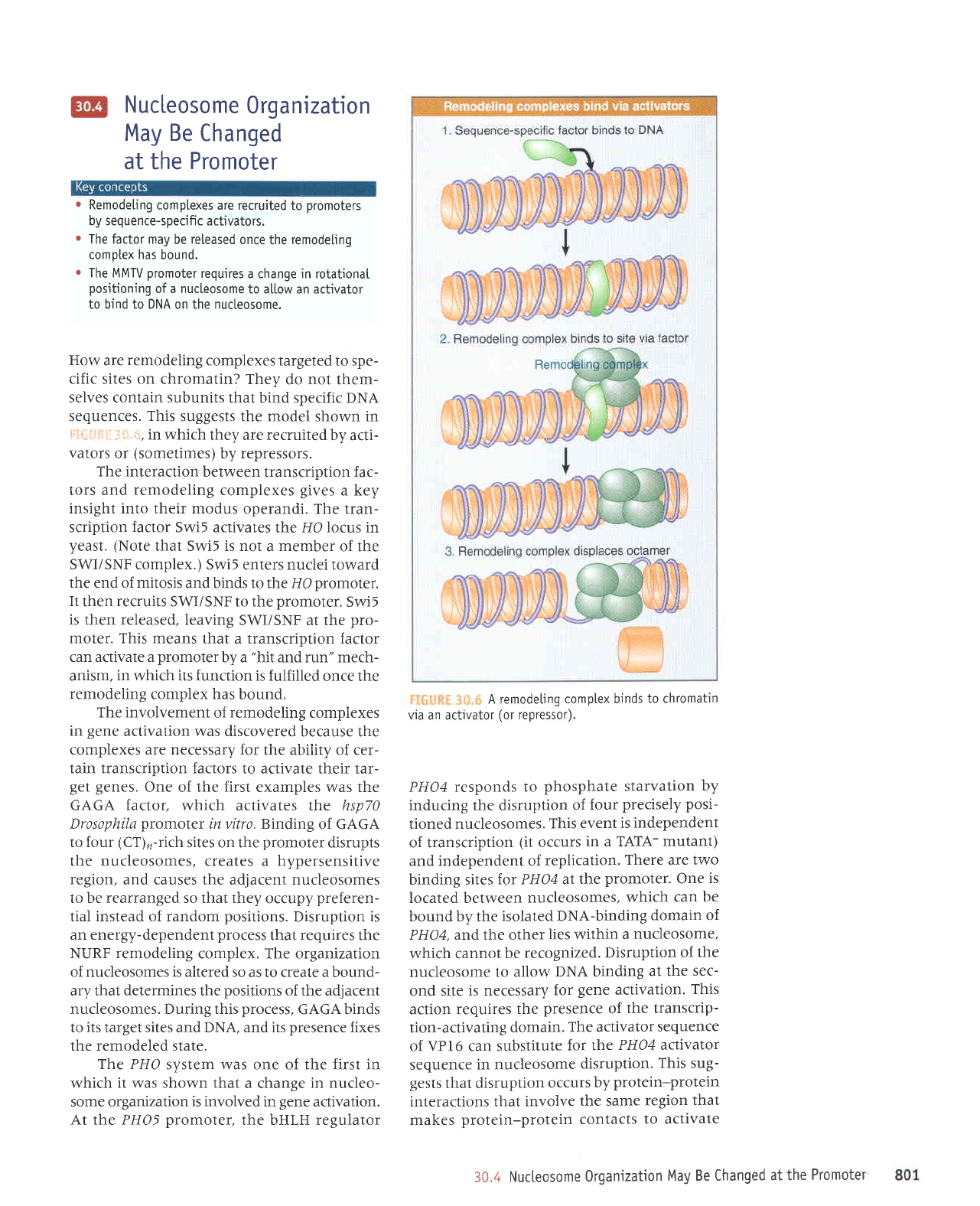
N ucLeosome
0rganization
May Be
Changed
at the
Promoter
r
Remodeling
complexes are recruited
to
promoters
by sequence-specifi c activators.
.
The factor may
be
reteased
once
the
remodeling
comptex has
bound.
r
The MMTV
promoter
requires
a change in rotational
positioning
of a nucleosome
to attow an activator
to bind to DNA on the nucleosome.
How are remodeling complexes
targeted to
spe-
cific
sites
on
chromatin? They
do not them-
selves contain subunits
that bind specific DNA
sequences.
This
suggests the model
shown in
!.1.-",r-ri,:i:
:;;:.1,,
in which
they are recruited
by acti-
vators
or
(sometimes)
by repressors.
The interaction
between
transcription fac-
tors and remodeling complexes
gives
a key
insight into their modus
operandi. The
tran-
scription
factor
Swi5 activates
the HO locus in
yeast. (Note
that Swi5 is not
a
member
of the
SWI/SNF complex.)
Swi5 enters nuclei toward
the
end of
mitosis
and binds to the IIO
promoter.
It
then
recruits
SWI/SNF to the
promoter.
Swi5
is then released, Ieaving
SWI/SNF at the
pro-
moter. This
means that a transcription factor
can activate a
promoter
by a
"hit
and run" mech-
anism,
in
which its function is fulfilled
once the
remodeling complex has
bound.
The involvement
of
remodeling
complexes
in
gene
activation was discovered
because the
complexes are necessary
for the ability of cer-
tain transcription factors
to activate their tar-
get genes.
One of the
first
examples was the
GAGA
factor,
which activates the hsp70
Drosophila
promoter
invitro. Binding
of GAGA
to four
(CT),-rich
sites on the
promoter
disrupts
the nucleosomes, creates
a
hypersensitive
region, and causes the adjacent nucleosomes
to be rearranged so that they
occupy
preferen-
tial instead of random
positions.
Disruption
is
an energy-dependent
process
that requires the
NURF
remodeling
complex. The organization
of nucleosomes is altered
so as to create a bound-
ary that determines the
positions
of the adjacent
nucleosomes. During this
process,
GAGA binds
to its target sites and DNA, and its
presence
fixes
the remodeled state.
The
PHO
system was one of the first in
which it
was
shown that
a change
in nucleo-
some organization
is involved
in
gene
activation.
At the PHO5
promoter,
the bHLH regulator
A remodeting
complex binds
to chromatin
via
an activator
(or
repressor).
PHO4 responds
to
phosphate
starvation
by
inducing the disruption
of
four
precisely
posi-
tioned nucleosomes.
This event
is
independent
of transcription
(it
occurs
in a TATA-
mutant)
and independent of
replication.
There
are two
binding sites
for PHO4 at
the
promoter.
One
is
located between
nucleosomes,
which
can
be
bound by the isolated
DNA-binding
domain of
PHO4, and the other
lies within
a
nucleosome,
which cannot
be
recognized.
Disruption
of the
nucleosome to allow
DNA binding
at the
sec-
ond site
is necessary
for
gene
activation.
This
action requires
the
presence
of
the transcrip-
tion-activating
domain.
The activator
sequence
of VPl6 can substitute
for the
PHO4 activator
sequence
in nucleosome
disruption.
This sug-
gests
that disruption
occurs
by
protein-protein
interactions that
involve
the same
region
that
makes
protein-protein contacts
to activate
30.4
Nucleosome
Organization
May Be Changed
at the
Promoter
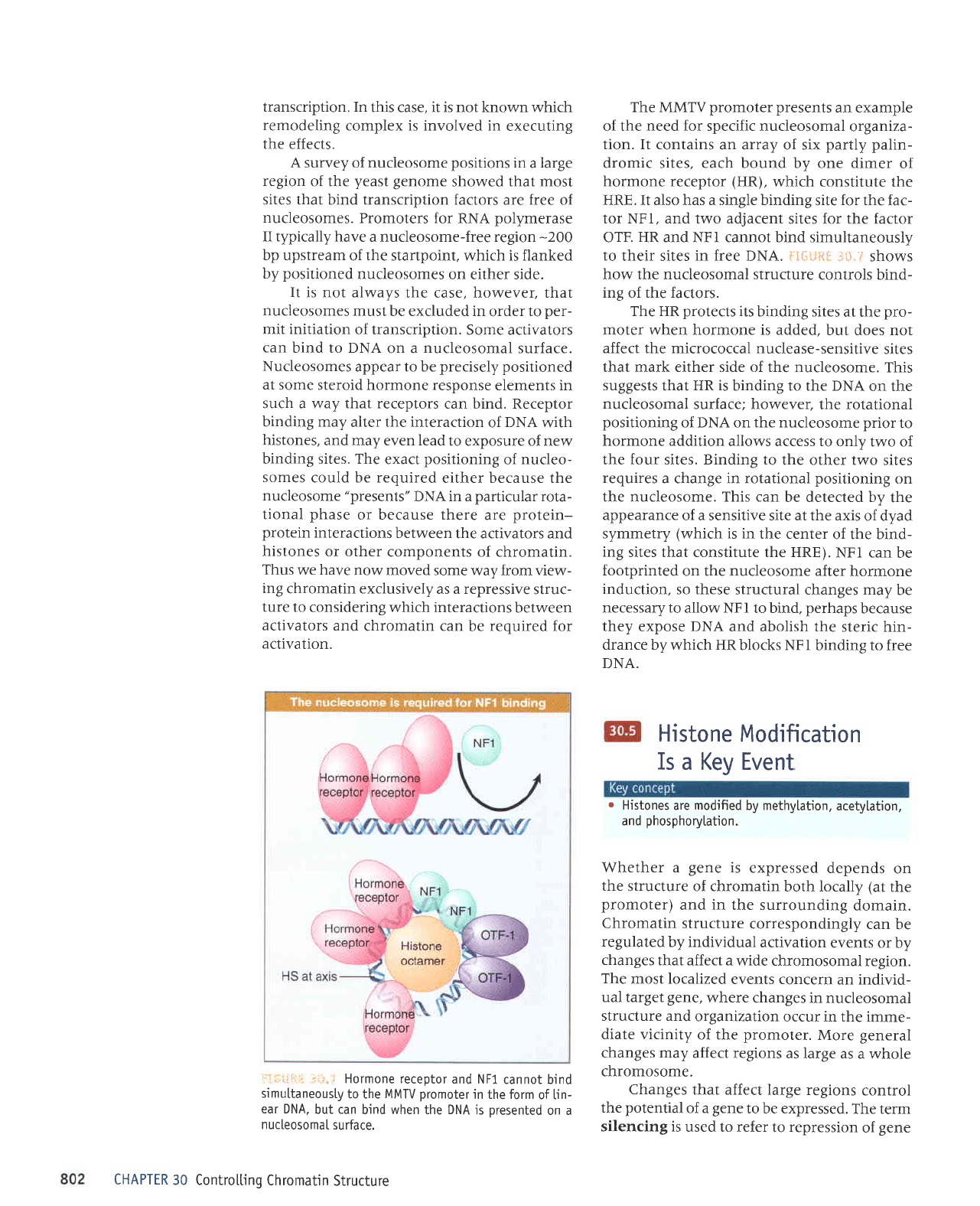
transcription. In
this case, it is not known which
remodeling
complex is involved in
executing
the effects.
A
survey of nucleosome
positions
in
a
large
region
of the
yeast
genome
showed that
most
sites that bind transcription factors
are
free
of
nucleosomes.
Promoters for
RNA
polymerase
II typically
have a nucleosome-free region
-200
bp upstream
of the startpoint, which is flanked
by
positioned
nucleosomes
on either side.
It is not always
the case, however, that
nucleosomes
must
be excluded in
order
to
per-
mit initiation
of transcription.
Some activators
can
bind to DNA
on a
nucleosomal
surface.
Nucleosomes
appear to be
precisely positioned
at
some steroid hormone response
elements in
such a way that receptors
can bind. Receptor
binding may
alter the interaction
of
DNA
with
histones,
and may even lead
to exposure of new
binding sites. The
exact
positioning
of
nucleo-
somes
could be required
either because the
nucleosome
"presents"
DNA in a
particular
rota-
tional
phase
or because there
are
protein-
protein
interactions
between
the activators and
histones
or other
components of chromatin.
Thus
we have
now moved some
way from
view-
ing
chromatin exclusively
as a repressive
struc-
ture
to considering
which interactions
between
activators
and
chromatin can
be
recuired
for
activation.
The MMTV
promoter presents
an example
of the need for specific nucleosomal
organiza-
tion. It contains
an array of six
partly palin-
dromic sites, each bound by one dimer
of
hormone
receptor
(HR),
which constitute
the
HRE. It also has a single binding
site
for
the fac-
tor
NFl,
and two adjacent
sites for the factor
OTF. HR and NFI cannot bind simultaneously
to
their sites
in free
DNA. i:I{li,iS*
;iii.!" shows
how the nucleosomal structure
controls bind-
ing
of
the factors.
The HR
protects
its
binding sires
at the
pro-
moter when hormone is added,
but does not
affect the micrococcal nuclease-sensitive
sites
that mark either side of the nucleosome.
This
suggests
that
HR is
binding to the DNA
on the
nucleosomal
surface; however,
the rotational
positioning
of DNA on the nucleosome prior
to
hormone addition
allows access to
only two of
the four sites. Binding to
the other two
sites
requires
a change in rotational
positioning
on
the nucleosome. This can
be detected by
the
appearance
of a sensitive site at the axis
of dyad
symmetry
(which
is in
the center
of the bind-
ing
sites that constitute the HRE).
NFI can
be
footprinted
on the nucleosome after
hormone
induction,
so these
structural changes may
be
necessary to
allow NFI to bind,
perhaps
because
they
expose
DNA
and abolish
the steric hin-
drance
by which HR blocks
NFI binding to free
DNA.
Histone
Modification
Is a Key Event
r
Histones
are
modified
by methytation,
acety[ation,
and
phosphorylation.
Whether a
gene
is
expressed
depends
on
the
structure of chromatin
both locally
(at
the
promoter)
and
in
the surrounding
domain.
Chromatin structure
correspondingly
can
be
regulated
by individual
activation
events
or by
changes
that affect a
wide chromosomal
region.
The
most localized
events concern
an individ-
ual target
gene,
where changes
in nucleosomal
structure and
organization
occur in the
imme-
diate vicinity
of the
promoter.
More
general
changes may
affect regions
as large
as a whole
chromosome.
Changes
that affect large
regions
control
the
potential
of a
gene
to be expressed.
The term
silencing is
used to refer
to
repression
of
gene
i:ir'ili;;i.
;ir
.i
Hormone receptor
and NF1
cannot bind
simuttaneously
to the MMTV
promoter
jn
the form
of [in-
ear DNA,
but can
bind when the DNA
is
oresented on a
nuc[eosomaI
surface,
CHAPTER
30 Controtting
Chromatin
Structure
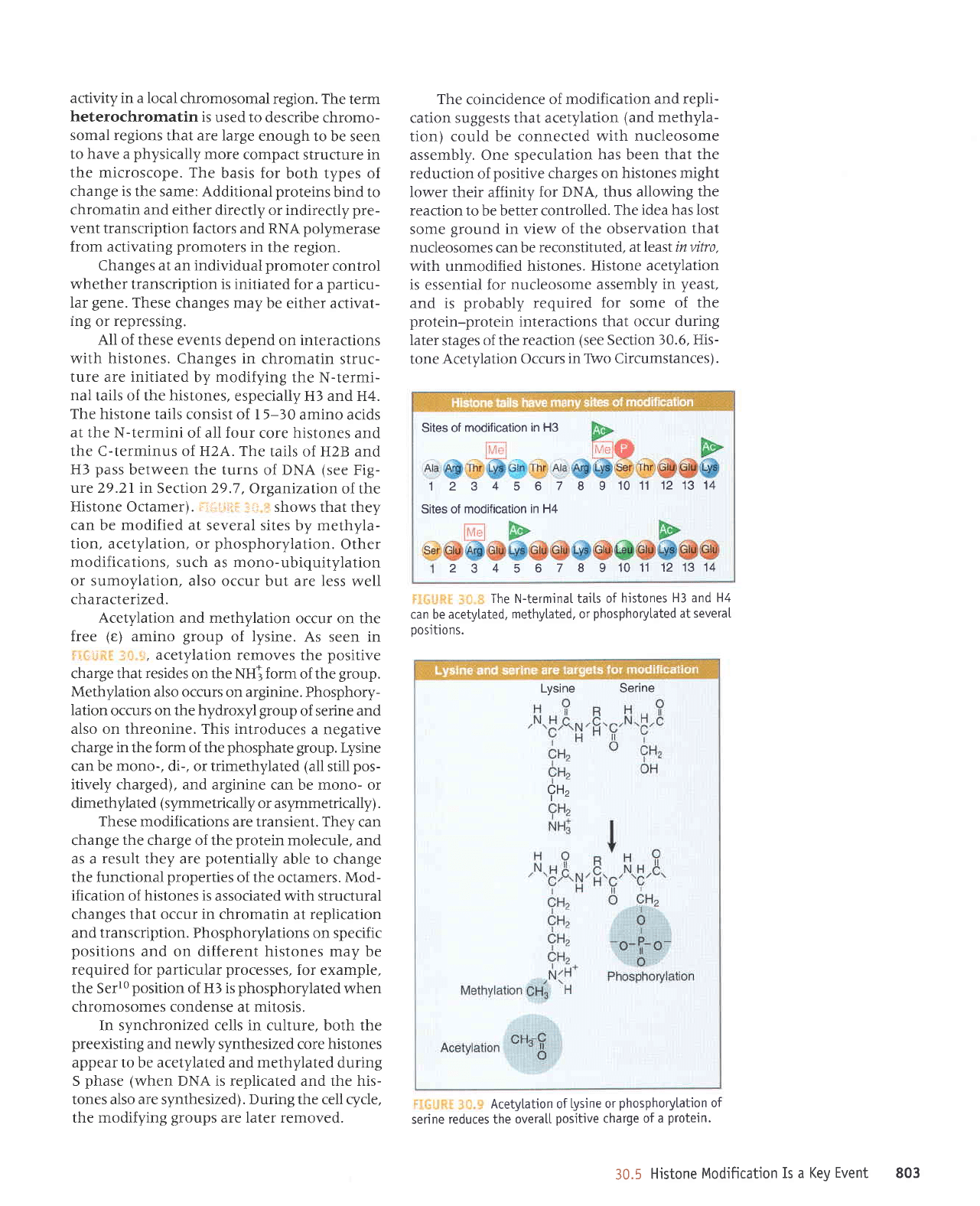
activity in a local
chromosomal
region.
The term
heterochromatin is
used to
describe chromo-
somal regions
that are large
enough
to be seen
to have a
physically
more
compact structure in
the microscope. The
basis for
both types of
change is the same: Additional
proteins
bind to
chromatin and either
directly or indirectly
pre-
vent transcription factors
and RNA
polymerase
from
activating
promoters
in
the region.
Changes at an individual promoter
control
whether transcription is initiated
for
a
particu-
lar
gene.
These
changes may
be either activat-
rng
or
represslng.
All of these
events depend
on interactions
with histones. Changes in
chromatin
struc-
ture are initiated
by
modifying
the N-termi-
nal
tails of the histones,
especially H3 and H4.
The histone tails
consist of 15-30
amino acids
at the
N-termini of all four
core histones and
the C-terminus of H2A. The
tails of H2B and
H3
pass
between the turns
of DNA
(see
Fig-
tre 29.21 in
Section 29.7
,
Organization
of the
Histone Octamer).
: 1i,,i.if
!:
:',
;,
shows that they
can be modified at
several sites
by
methyla-
tion.
acetylation, or
phosphorylation.
Other
modifications, such as mono-ubiquitylation
or sumoylation, also occur
but are
less
well
characterized.
Acetylation
and methylation
occur on the
free
(e)
amino
group
of lysine. As seen in
I
i
i
',
i,
acetylation
removes the
positive
charge that
resides
on the
NHI
form
of the
group.
Methylation also occurs
on
arginine.
Phosphory-
lation
occurs on the
hydroxyl
group
of serine and
also on threonine. This introduces
a negative
charge
in
the
form
of the
phosphate
group.
Lysine
can be mono-, di-, or trimethylated
(all
still
pos-
itively charged), and arginine
can be mono- or
dimethylated
(symmetrically
or asymmetrically).
These modifications are transient.
They can
change
the
charge of the
protein
molecule, and
as a result they are
potentially
able
to change
the functional
properties
of the octamers. Mod-
ification
of
histones is
associated with structural
changes that occur in chromatin
at
replication
and transcription. Phosphorylations
on specific
positions
and on different histones may be
required for
particular
processes,
for
example,
the Serr0
position
of Hl is
phosphorylated
when
chromosomes condense
at mitosis.
In synchronized cells in culture, both the
preexisting
and newly
synthesized core histones
appear to be acetylated and methylated
during
S
phase
(when
DNA is replicated and the his-
tones also are synthesized). During the cell
rycle,
the modifying
groups
are later removed.
The
coincidence
of modification
and repli-
cation suggests that acetylation
(and
methyla-
tion)
could
be connected with
nucleosome
assembly. One speculation
has been
that the
reduction
of
positive
charges on
histones might
lower their affinity for
DNA, thus allowing
the
reaction to
be
better controlled.
The
idea has lost
some
ground
in view of the observation
that
nucleosomes can be
reconstituted,
at least invitro,
with
unmodified
histones.
Histone acetylation
is essential for nucleosome
assembly
in
yeast,
and is
probably
required
for some
of the
protein-protein
interactions
that occur during
later
stages
of the reaction
(see
Section
10.6, His-
tone Acetylation
Occurs
in TWo Circumstances).
The N-terminaL tai[s of
histones
H3 and H4
can be acetytated,
methylated, or
phosphorylated
at
severaI
positions.
Acetylation of
Lysine or
phosphorylation
of
Sites of modification
in H3
1 2 3
4
5 6
7 I I
1011
121314
Sites of modiiication
in H4
2
3
4
5
6
7 8 I 1011
121314
Lysine Serine
CH,
t-
serine reduces the
overatl
positive
charge
of a
protein.
30.5
Histone
Modification
Is a Kev
Event
803
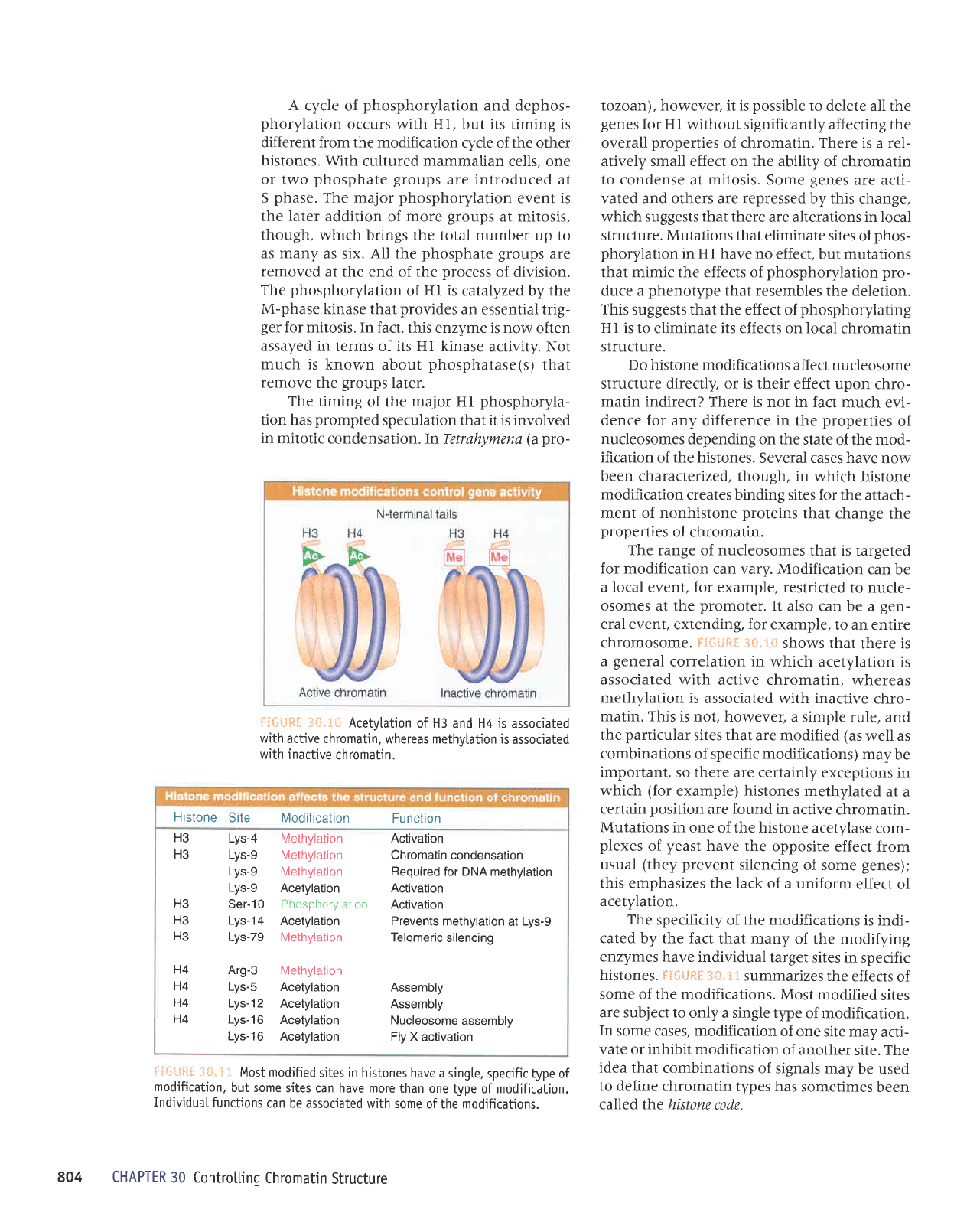
A
cycle of
phosphorylation
and dephos-
phorylation
occurs with HI,
but
its
timing
is
different from the modification
cycle of the other
histones.
With
cultured
mammalian
cells, one
or two
phosphate groups
are introduced at
S
phase.
The major
phosphorylation
event
is
the later addition
of
more
groups
at mitosis,
though, which
brings the total number up to
as many
as six. AII the
phosphate groups
are
removed
at the end of the
process
of division.
The
phosphorylation
of HI is catalyzed
by
the
M-phase
kinase that
provides
an essential trig-
ger
for mitosis. In fact,
this enzyme is now
often
assayed
in terms of its Hl kinase
activity. Nor
much is
known about
phosphatase(s)
that
remove
the
groups
later.
The timing
of the major Hl
phosphoryla-
tion has
prompted
speculation
that it is involved
in
mitotic condensation.
In Tetrahymena
(a
pro-
f,:Slifif
-:*.1* Acetylation
of H3 and H4 is
associated
with
active chromatin,
whereas methvlation is
associated
with
inactive
chromatin.
f?fi ijR$
i*".! 1
Most modified
s'ites in histones have
a single.
specific type of
modification,
but some
sites can have more
than one
type of modification.
IndividuaI
functions
can be
associated with some
of the modifications.
tozoarrl, however, it is
possible
to delete all the
genes
for Hl without significantly affecting the
overall
properties
of chromatin. There
is a rel-
atively small effect on the ability
of chromatin
to condense
at
mitosis.
Some
genes
are acti-
vated and others are repressed by this
change,
which suggests that
there are alterations in local
structure.
Mutations
that eliminate sites
of
phos-
phorylation
in
Hl have no effect, but mutations
that mimic the effects of
phosphorylation
pro-
duce a
phenotype
that resembles the
deletion.
This suggests that
the effect of
phosphorylating
HI is
to eliminate its effects on local
chromatin
structure.
Do histone modifications
affect nucleosome
structure directly, or is their effect
upon chro-
matin indirect?
There is not in fact
much evi-
dence for any
difference
in
the
properties
of
nucleosomes depending on the
state of the mod-
ification of the histones.
Several cases have
now
been
characterized, though, in which
histone
modification
creates binding
sites for the attach-
ment of nonhistone
proteins
that change
the
properties
oI chroma tin.
The range of nucleosomes
that is
targeted
for modification
can vary. Modification
can be
a
local
event, for example, restricted
to nucle-
osomes at the
promoter.
It
also can
be a
gen-
eral event,
extending, for example,
to an entire
chromosome.
FSli#R*
3*,:!*
shows that
there is
a
general
correlation
in
which
acetylation is
associated
with active chromatin,
whereas
methylation is
associated with inactive
chro-
matin. This
is not, however,
a simple rule,
and
the
particular
sites that are modified
(as
well as
combinations of specific modifications)
may
be
important, so
there are certainly
exceptions in
which (for
example) histones methylated
at
a
certain
position
are found in active
chromatin.
Mutations in
one of the histone
acetylase
com-
plexes
of
yeast
have
the opposite
effect from
usual
(they prevent
silencing
of some
genes);
this emphasizes the lack
of a uniform
effect
of
acetylation.
The
specificity
of
the modifications
is indi-
cated by the fact
that many
of the modifying
enzymes
have individual
target sites
in specific
histones. fg$ilftil
3*"?'i summarizes
the
effects of
some of the modifications.
Most
modified
sites
are subject to
only a single type
of modification.
In
some cases, modification
of
one site may
acti-
vate or inhibit modification
of another
site. The
idea that
combinations
of signals
may be
used
to define chromatin
types has
sometimes
been
called the histone
code.
Histone
Site Modilication
Function
H3
Lys-4 Methylation
Activation
H3
Lys-9 l,4ethylation
Chromatin
condensation
Lys-9 Methylation Required
for DNA methylation
Lys-9
Acetylation Activation
H3
Ser-10
Phosphorylation
Activation
H3
Lys-14
Acetylation Prevents
methylation
at Lys-g
H3
Lys-79 Methylation
Telomeric
silencing
H4
Arg-3
Methylation
H4
Lys-S
Acetylation
Assembly
H4
Lys-12
Acetylation
Assembly
H4
Lys-16
Acetylation
Nucleosome
assembly
Lys-16
Acetylation Fly
X activation
804
CHAPTER
30 Controllinq
Chromatin
Structure
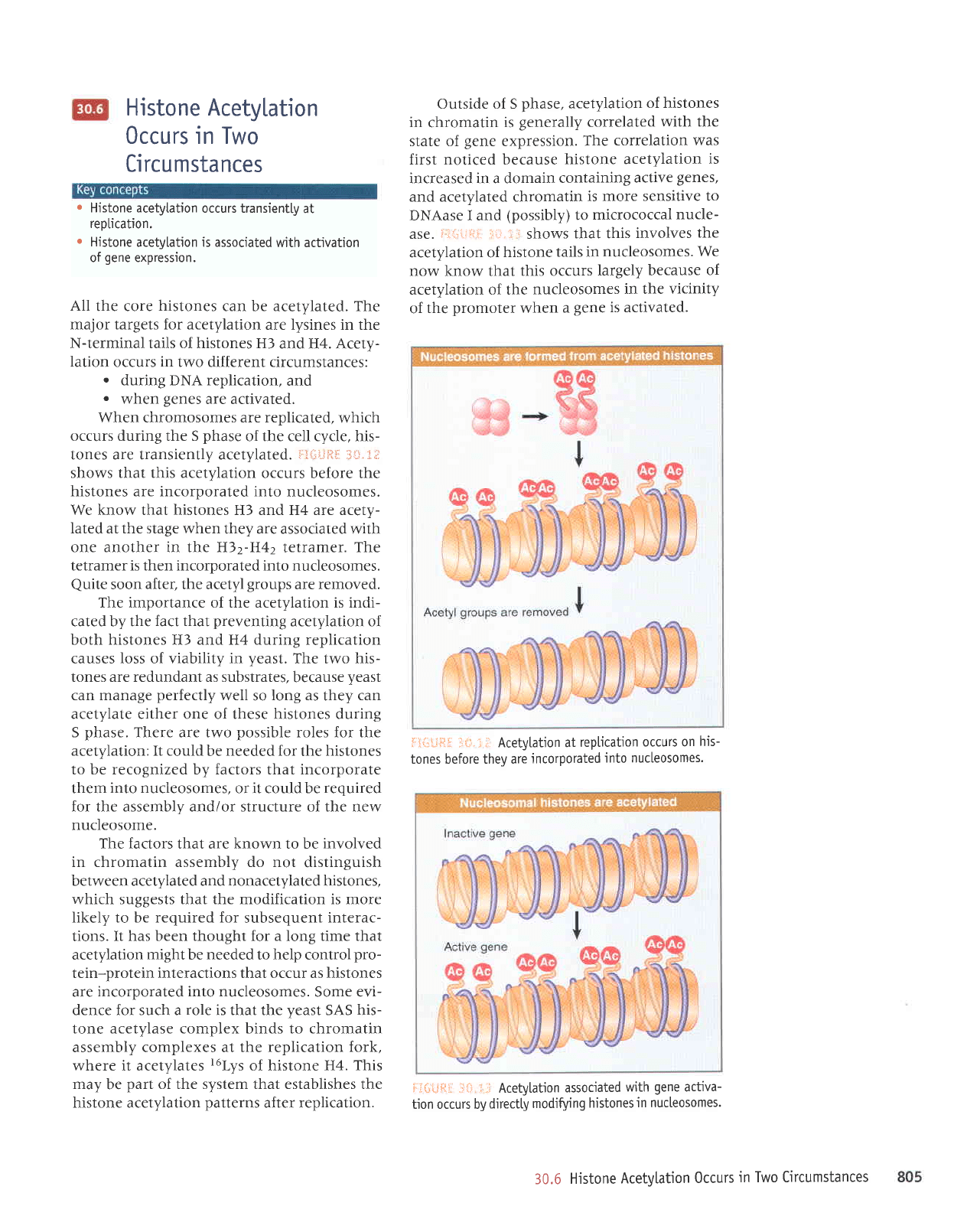
Histone Acetylation
0ccurs in Two
Circumstances
.
Histone acetytation
occurs transiently
at
rentication.
r
Histone
acetylation is associated
with activation
of
gene
expression.
All
the core
histones
can be acetylated. The
major targets for acetylation
are lysines in the
N-terminal tails of histones H3
and H4. Acety-
lation
occurs
in
two different circumstances:
.
during DNA replication,
and
.
when
genes
are activated.
When chromosomes are replicated.
which
occurs during the S
phase
of the cell cycle, his-
tones are transiently acetylated.
i: :
t:
i,i iji I
;,{
:.r
* -i ;i
shows that this acetylation
occurs before the
histones are incorporated into
nucleosomes.
We know that histones Hl and H4 are acety-
lated at the stage
when
they are associated with
one another in the H)2-H42
tetramer.
The
tetramer is then incorporated into nucleosomes.
Quite
soon after, the acetyl
groups
are removed.
The importance of the acetylation is indi-
cated by the
fact that
preventing
acetylation of
both histones H3 and H4 during replication
causes loss of viability in
yeast.
The two his-
tones are redundant as substrates.
because
yeast
can manage
perfectly
well
so
long as
they
can
acetylate either one of these histones during
S
phase.
There are two
possible
roles for the
acetylation: It could
be
needed for
the
histones
to be recognized by factors that incorporate
them
into nucleosomes,
or it could be
required
for the assembly and/or structure of the new
nucleosome.
The factors that are known to be involved
in chromatin assembly do not
distinguish
between acetylated and nonacetylated histones,
which suggests that the modification is more
likely to be required for
subsequent
interac-
tions.
It has been thought for a long time that
acetylation
might
be
needed
to help control
pro-
tein-protein interactions that occur as histones
are
incorporated into nucleosomes.
Some evi-
dence for such a
role
is that the
yeast
SAS his-
tone acetylase complex binds to chromatin
assembly complexes at the
replication fork,
where
it acetylates
r6lys
of histone H4.
This
may
be
part
of the system that establishes the
histone acetylation
patterns
after replication.
Outside of S
phase,
acetylation
of histones
in
chromatin
is
generally correlated
with
the
state of
gene
expression.
The
correlation was
first noticed because
histone acetylation
is
increased in a domain
containing
active
genes,
and acetylated chromatin
is
more sensitive to
DNAase I and
(possibly)
to
micrococcal
nucle-
ase.
i.i*:ritiS:
ii.r.:lri
shows
that this
involves
the
acetylation of
histone
tails in
nucleosomes. We
now know that
this occurs
largely because
of
acetylation of the
nucleosomes
in the vicinity
of
the
promoter
when
a
gene
is activated.
irI{.il,lHf
i+-i.i.i
Acetytation at
rep[ication
occurs on
his-
tones before they are
incorporated
into nucleosomes.
lI{,ilfiii
;ii,t.1.:i
Acetytation
associated
with
gene
activa-
tjon occurs by
directty
modifoing
histones
in nucleosomes.
30.6
Histone
Acetytation
Occurs
in Two Circumstances
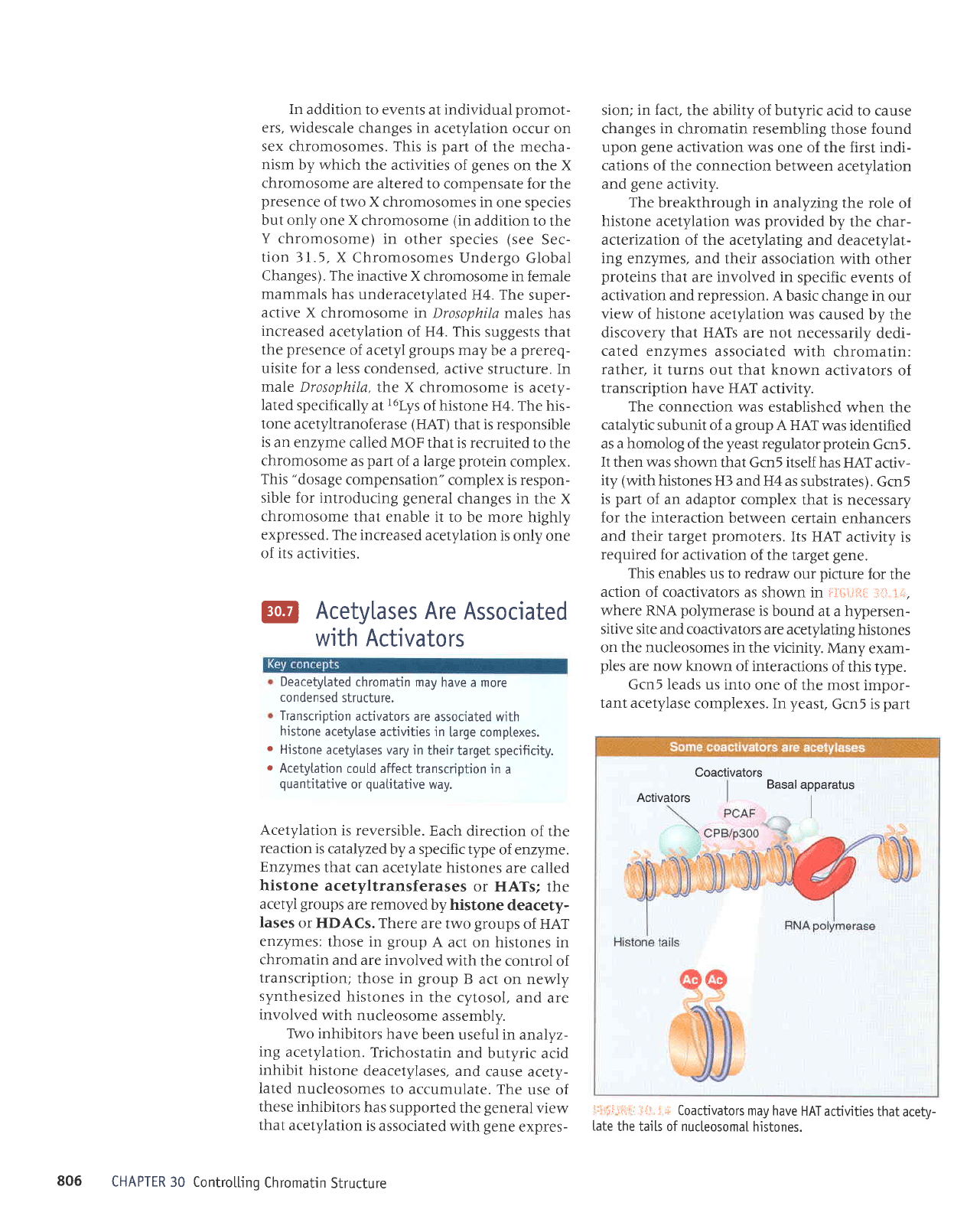
In
addition to events
at
individual
promot-
ers,
widescale changes in
acetylation occur
on
sex chromosomes. This
is
part
of the mecha-
nism by which
the activities
of
genes
on the X
chromosome
are altered to
compensate for the
presence
of two X chromosomes
in
one species
but only
one
X
chromosome
(in
addition to the
Y chromosome)
in
other species
(see
Sec-
tion 31.5, X
Chromosomes
Undergo Global
Changes). The
inactive X chromosome
in female
mammals
has underacetylated
H4. The
super-
active
X chromosome
in Drosophila males
has
increased
acetylation of H4. This
suggests that
the
presence
of acetyl
groups
may
be a
prereq-
uisite for a less
condensed,
active structure. In
male Drosophila,
the X
chromosome is
acety-
Iated
specifically at
r6lys
of histone H4. The
his-
tone
acetyltranoferase
(HAI)
that is responsible
is
an enzyme
calied MOF that is
recruited to
the
chromosome
as
part
of a
large protein
complex.
This
"dosage
compensation"
complex is respon-
sible for introducing general
changes in
the X
chromosome
that enable it to
be more highly
expressed.
The increased
acetylation
is only
one
of its activities.
o
a
@
Acetylases
Are
Associated
with Activators
Deacetytated
chromatin may
have a more
condensed
structure.
Transcription
activators are
associated with
histone
acetytase
activities in
[arge comptexes.
Histone
acetytases vary in
their target specificity.
Acetytation
could affect
transcription in
a
quantitative
or
quatitative
way.
Acetylation
is reversible.
Each
direction of the
reaction
is
catalyzed
by a specific type
of enzyme.
Enzymes
that can acetylate
histones
are called
histone
acetyltransferases
or HATs;
the
acetyi
groups
are removed
by histone
deacety-
lases
or HDACs.
There
are two
groups
of HAT
enzymes:
those in
group
A
act on histones in
chromatin
and are involved
with
the control
of
transcription;
those in
group
B
act on newly
synthesized
histones in
the cytosol,
and
are
involved
with
nucleosome
assembly.
lWo inhibitors
have
been
useful in analyz-
ing
acetylation.
Trichosratin
and butyric
acid
inhibit
histone
deacetylases,
and
cause acety-
lated
nucleosomes
to
accumulate.
The
use of
these
inhibitors
has supported
the
general
view
that
acetylation
is
associated
with
gene
expres-
CHAPTER
30 Controtling
Chromatin
Structure
sion;
in fact,
the ability of butyric
acid to cause
changes in chromatin resembling
those found
upon
gene
activation
was one of the first
indi-
cations of
the connection between
acetylation
and
gene
activity.
The breakthrough in
analyzing the role
of
histone acetylation
was
provided
by the char-
acterization of the acetylating
and deacetylat-
ing
enzymes, and their association
with other
proteins
that are involved in
specific events
of
activation and repression. A
basic change in
our
view
of
histone
acetylation was
caused by the
discovery that HATs are not
necessarily
dedi-
cated enzymes
associated with
chromatin:
rather,
it turns out that known
activators
of
transcription have
HAT activity.
The connection
was established
when
the
catalytic
subunit of a
group
A HAI
was identified
as a homolog of the
yeast
regulator protein
Gcn5.
It then
was
shonm that Gcn5 itself
has HAI
activ-
ity
(with
histones H3
and H4 as
substrates).
Gcn5
is
part
of an adaptor complex
that is necessary
for
the interaction between
certain
enhancers
and their target
promoters.
Its HAT
activity is
required for
activation
of the target
gene.
This enables
us to
redraw
our
picture
for
the
action
of coactivators as
shown in
f],{-iiit,Ji:
il{"}.11
.:.,
where
RNA
polymerase
is
bound
at a hypersen-
sitive site and coactivators
are acetylating
histones
on the nucleosomes in
the
vicinity.
Many
exam-
ples
are now
known of interactions
of this t1pe.
Gcn5 leads us into
one of the
most impor-
tant acetylase
complexes. In
yeast,
Gcn5 is
part
Coactivators
Basal
apparatus
Activators
I 5r;iili!: .;tl,,.i
+
Coactivators may have
HAT activities
that
acety-
late
the tai[s of nucleosomaI
histones.
806
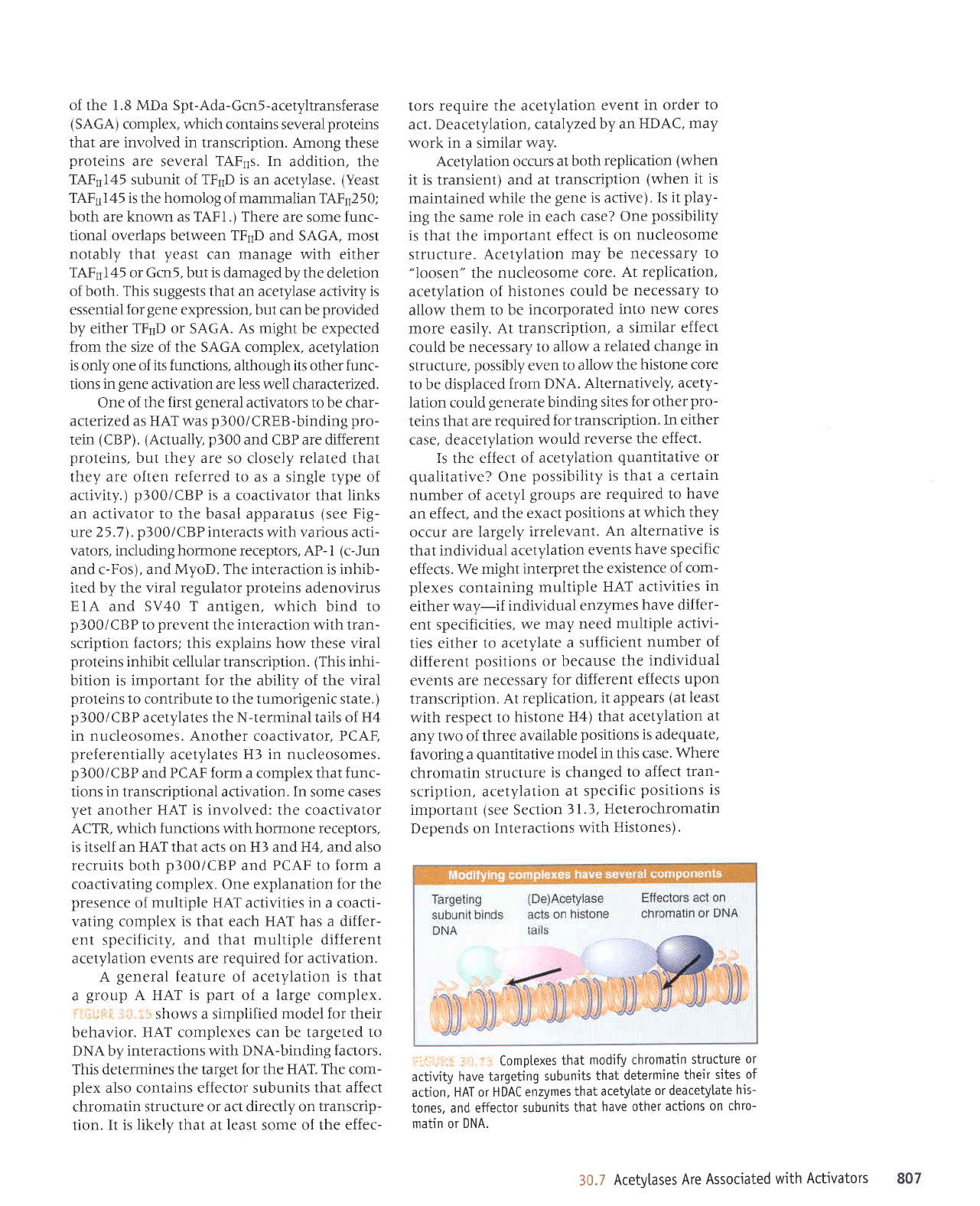
of the 1.8 MDa Spt-Ada-Gcn5-acetyltransferase
(
SAGA) complex, which contains
several
proteins
that are involved in transcription.
Among these
proteins
are several TAF1s. In
addition, the
TAFtr145 subunit of TFnD is
an acetylase.
(Yeast
TAF1l4S is
the
homolog
of mammalian TAF1250;
both are known as TAFI.) There
are some func-
tional overlaps between TFnD
and SAGA,
most
notably that
yeast
can manage with either
TAFrrl45 or Gcn5, but is damaged
by the deletion
of both.
This
suggests that an acetylase activity is
essential
for
gene
expression, but
can be
provided
by either
TFnD
or SAGA. As might be expected
from the size of the SAGA complex,
acetylation
is
only
one of its functions,
although its other
func-
tions
in
gene
activation
are
less
well characterized.
One of the first
general
activators to be char-
acterized as HAT was
p300/CREB-binding pro-
tein
(CBP). (Actually, p300
and CBP are different
proteins,
but they are
so closely
related
that
they are often
referred
to as a single type of
activity.)
p300/CBP
is a coactivator
that
links
an
activator to the basal
apparatus
(see
Fig-
ure
25.7).
p300/CBP
interacts
with various acti-
vators,
including horrnone receptors, AP- I
(c-Jun
and c-Fos), and
MyoD.
The interaction is inhib-
ited by the viral regulator
proteins
adenovirus
EIA and SV40 T antigen, which
bind
to
p300/CBP
to
prevent
the
interaction
with tran-
scription factors; this explains how these viral
proteins
inhibit cellular transcription.
(This
inhi-
bition is important for the ability of the
viral
proteins
to contribute to the tumorigenic state.)
p300/CBP
acetylates the N-terminal tails of
H4
in nucleosomes. Another coactivator, PCAF,
preferentially
acetylates
H3 in
nucleosomes.
p300/CBP
and PCAF form a complex that func-
tions
in
transcriptional activation.
In
some
cases
yet
another
HAT is involved:
the coactivator
ACTR, which functions with hormone receptors,
is itself an HAT that acts on H3 and H4, and aiso
recruits both
p300/CBP
and
PCAF
to
form a
coactivating
complex. One explanation for the
presence
of multiple HAT activities in a coacti-
vating complex
is that each HAT has a differ-
ent specificity,
and that multiple different
acetylation events
are required for activation.
A
general
feature
oI acetylation
is that
a
group
A HAT is
part
of a large complex.
,''!r.ri:r,:
1r..
:
:
shows a simplified
model for their
behavior. HAT complexes can be targeted
to
DNA
by
interactions with DNA-binding
factors.
This determines the target
for
the
HAT. The com-
plex
also contains effector subunits that
affect
chromatin structure or act directly on
transcrip-
tion.
It is likely that at least some of the
effec-
tors
require the acetylation
event
in order
to
act. Deacetylation,
catalyzed
by an
HDAC, may
work in a
similar
way.
Acetylation occurs
at both
replication
(when
it is transient) and
at transcription
(when it is
maintained while the
gene is active).
Is it
play-
ing the same
role in each
case? One
possibility
is that the
important effect
is
on
nucleosome
structure.
Acetylation
may
be necessary
to
"loosen"
the
nucleosome
core.
At replication,
acetylation of
histones could
be
necessary
to
allow them
to be
incorporated
into
new cores
more easily.
At transcription,
a
similar effect
could be
necessary
to allow
a related
change
in
structure,
possibly
even
to allow
the
histone core
to be displaced
from
DNA. Alternatively,
acety-
Iation could
generate
binding
sites
for other
pro-
teins that
are required
for
transcription.
In either
case, deacetylation
would
reverse
the effect.
Is
the
effect of
acetylation
quantitative
or
qualitative?
One
possibility is that
a certain
number of acetyl
groups are
required to
have
an
effect, and the
exact
positions at which
they
occur
are largely
irrelevant.
An alternative
is
that individual
acetylation
events
have specific
effects. We
might
interpret
the existence
of com-
plexes
containing
multiple
HAT activities
in
either way-if
individual
enzymes
have differ-
ent specificities,
we may
need
multiple
activi-
ties either
to acetylate
a
sufficient
number
of
different
positions
or
because
the
individual
events are
necessary
for
different
effects
upon
transcription.
At replication,
it appears
(at
least
with
respect to
histone
H4) that
acetylation
at
any two of
three available
positions is adequate,
favoring a
quantitative model
in this
case.
Where
chromatin
structure
is
changed
to affect
tran-
scription, acetylation
at specific
positions is
important
(see
Section
31.3,
Heterochromatin
Depends on
Interactions
with
Histones).
r
ii-ii
jrri
ii.,. r
1,
Comptexes
that
modify chromatin
structure
or
activity
have targeting
subunits
that
determine
their
sites of
action,
HAT or HDAC
enzymes
that acetytate
or deacetytate
his-
tones, and effector
subunits
that
have other
actions on
chro-
matin or
DNA.
30.7
Acetytases
Are
Associated
with
Activators
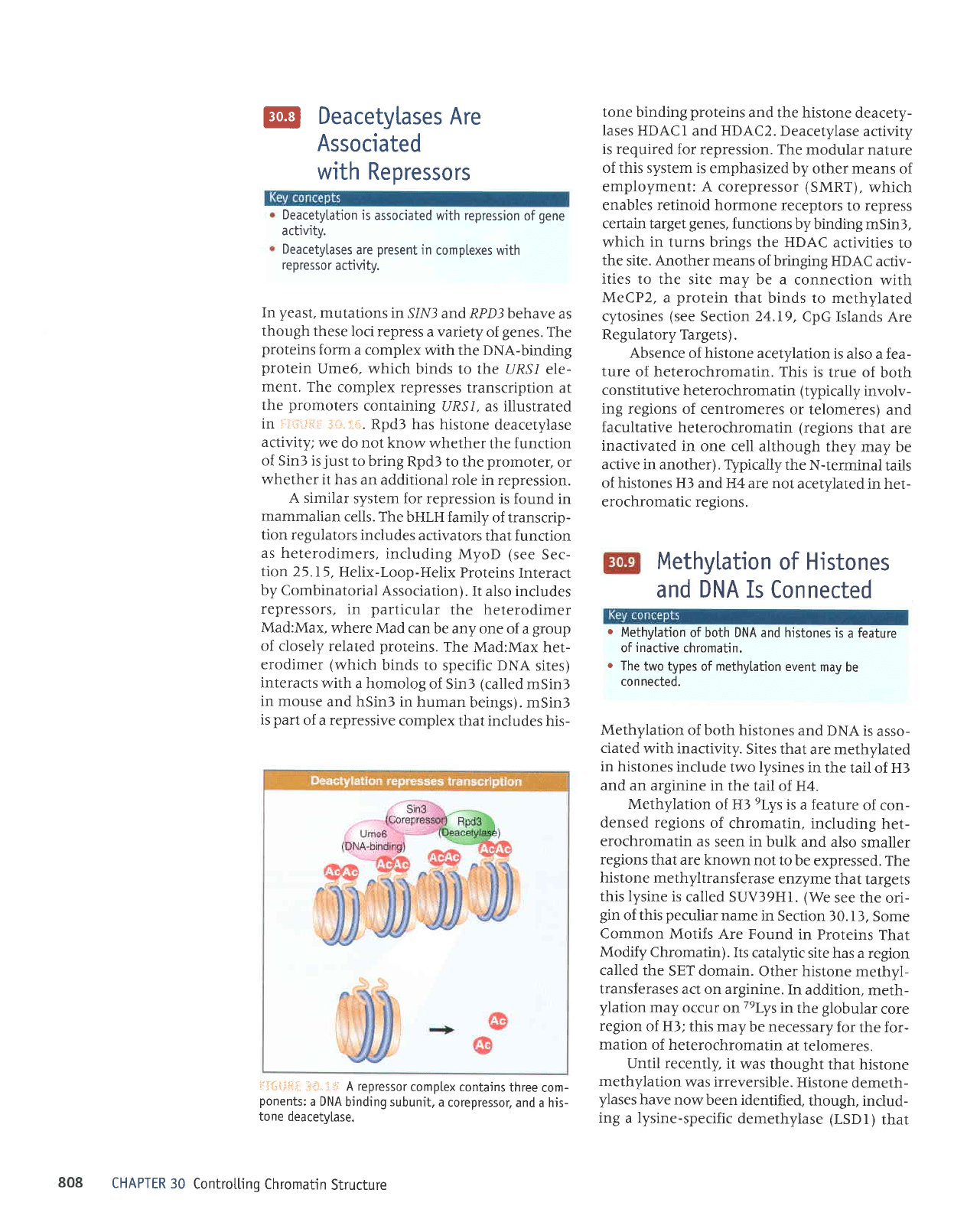
@
Deacetylases
Are
Associated
with
Repressors
Deacetytation
is
associated with repression
of
gene
activity.
Deacetytases
are
present
in
complexes with
repressor
activity.
In
yeast,
mutations
in SlNf
and RPD3 behave
as
though
these
loci repress
a variety
of
genes.
The
proteins
form
a complex
with the DNA-binding
protein
Ume6, which
binds
to the URS/
ele-
ment. The
complex represses
transcription
at
the
promoters
containing
URSl, as illustrated
in :.:i='"titi.:
';i.i.ii.
Rpd3 has
histone
deacetylase
activity;
we
do not know
whether
the function
of SinS is
just
to bring
Rpd3 to
the
promoter,
or
whether
it has
an additional
role in repression.
A similar
system for
repression
is found in
mammalian
cells. The
bHLH family
of transcrip-
tion regulators
includes
activators
that function
as heterodimers,
including
MyoD
(see
Sec-
tion
25. I 5,
Helix-Loop-Helix
Proteins
Interact
by
Combinatorial
Association).
It also includes
repressors,
in
particular
the
heterodimer
Mad:Max,
where
Mad can
be any one
of a
group
of closely
related
proteins.
The Mad:Max
het-
erodimer
(which
binds to
specific DNA
sites)
interacts
with
a homolog
of Sinl
(called
mSin3
in
mouse
and hSinS in
human
beings). mSin3
is
part
of a repressive
complex
that includes
his-
iriiltliii;
"i;;.
-i+ A repressor
comptex contains
three
com-
ponents:
a DNA
binding subunit,
a
corepressor,
and a his-
tone deacety[ase.
CHAPTER
30
Controlting
Chromatin
Structure
tone binding
proteins
and the histone
deacety-
Iases HDAC I
and
HDAC2.
Deacetylase
activity
is required
for repression.
The modular nature
of this system is
emphasized
by other means
of
employment: A corepressor
(SMRT),
which
enables retinoid hormone
receptors
to repress
certain target
genes,
functions
by
binding mSin3,
which in turns
brings the HDAC
activities
to
the
site. Another means
of bringing HDAC
activ-
ities to the
site may be a
connection
with
MeCP2,
a
protein
that
binds to methylated
cytosines
(see
Section
24.19,
CpG Islands Are
Regulatory Targets).
Absence
of histone acetylation
is
also a fea-
ture
of heterochromatin.
This is
true of
both
constitutive
heterochromatin
(
typically
involv-
ing
regions of centromeres
or
telomeres)
and
facultative heterochromatin (regions
that are
inactivated
in one cell
although they
may
be
active in another). T\upically
the
N-terminal
tails
of histones H3
and H4 are not
acetylated
in het-
erochromatic regions.
Methylation
of Histones
and DNA Is
Connected
o
Methytation
of both DNA and histones
is
a
feature
of
inactive
chromatin.
o
The
two types
of
methytation
event
may be
con nected.
Methylation
of both histones
and
DNA is
asso-
ciated
with inactivity.
Sites that
are methylated
in histones
include
two lysines
in the
tail of H3
and an
arginine in the
tail of H4.
Methylation
of H3
elys
is
a feature
of con-
densed regions
of
chromatin,
including
het-
erochromatin
as
seen in bulk
and also
smaller
regions
that are known
not to
be expressed.
The
histone
methyltransferase
enzyme
that
targets
this lysine
is
called SUV39Hl.
(We
see rhe
ori-
gin
of this
peculiar
name
in Section
30.13,
Some
Common Motifs
Are Found
in Proteins
That
Modify Chromatin).Its
catalytic
site has a region
called the
SET domain.
Other histone
methyl-
transferases
act on arginine.
In
addition,
meth-
ylation
may occur
on
Telys
in
the
globular
core
region
of H3; this may
be necessary
for
the for-
mation
of heterochromatin
at telomeres.
Until recently,
it
was thought
that
histone
methylation
was irreversible.
Histone
demeth-
ylases
have now
been identified,
though, includ-
ing
a lysine-specific
demethylase (LSDI)
that

acts on
I(4
of histone H3,
and an enzyme
that
demethylates arginine on histones
Hl and H4.
We do not
yet
know
how
demethylation is
regulated.
Most of the methylation
sites in DNA
are
CpG islands
(see
Section 24.19,
CpG Islands
Are Regulatory Targets).
CpG
sequences in het-
erochromatin are
usually methylated.
Con-
versely, it is necessary
for the
CpG
islands
located in
promoter
regions
to be unmeth-
ylated
in order for
a
gene
to be expressed
(see
Section
24.18,
Gene Expression
Is Associated
with
Demethylation).
Methylation of DNA
and methylation of
histones is
connected in a mutually reinforcing
circuit. Methylation
of
H3 is
the signal that
recruits the DNA methylase
to chromatin. The
order of events is that H3
el,ys
is
deacetylated
to
create
the substrate
for methylation. H3 is
then converted to the Meelys
or the
Me2elys
condition, which
provides
a binding site
for
the
DNA methylase. Some histone
methyltrans-
ferase enzymes contain
potential
binding sites
for the methylated CpG doublet,
so the
DNA
methylation reinforces
the circuit by
providing
a large| for the histone methyltransferase
to
bind.
The important
point
is that
one
type
of
modification can be the
trigger for another.
These
systems are widespread, as seen by evi-
dence for these connections in fungi,
plants,
and animal cells, and for regulating transcrip-
tion at
promoters
used by both RNA
poly-
merases I and II, as well
as
maintaining
heterochromatin in an inert
state.
Chromatin States
Are Interconverted
by
Modification
Acetytation of histones is associated with
gene
activation.
Methytation of DNA and
of
histones is
associated
with heterochromatin.
irii:i:ltir
::ij. i
;'
summarizes three types of differ-
ences
that are found between
active chromatin
and inactive chromatin:
.
Active chromatin is acetylated on the
tails of histones H3 and H4.
.
Inactive chromatin is methylated on
el-ys
of
histone H3.
.
Inactive
chromatin
is methylated
on
cytosines of CpG doublets.
The reverse types of
events occur
if
we
com-
pare
the activation
of a
promoter
with the
gen-
eration of
heterochromatin.
The actions
of the
enzymes that
modify chromatin
ensure that acti-
vating events are
mutually exclusive
with
inac-
tivating events.
Methylation
of
H3
el-ys
and
acetylation of H3
lalys
are mutually
antagonistic.
Acetylases and deacetylases
may trigger
the
initiating events.
Deacetylation
allows
methy-
lation to occur, which
causes
formation of a
het-
erochromatic
complex
(see
Section
31.3,
Heterochromatin
Depends on
Interactions with
Histones).
Acetylation
marks a region
as active
(see
Section
10. I l,
Promoter
Activation
Involves
an Ordered Series
of
Events).
Promoter
Activation
Involves an
0rdered
Series
of
Events
o
The remode[ing comptex
may recruit the
acetylating comp[ex.
o
Acetytation of
histones
may be the
event that
maintajns the complex
in the activated
state.
How are acetylases
(or
deacetylases)
recruited
to their specific targets?
As we have
seen with
remodeling
complexes,
the
process is likely to
i
l.tiiiii:t:
..rii.
i
:
Acetylation
of
histones activates
chro-
matin, and methylation
of
DNA and
histones
inactivates
ch ro mati
n.
30.11
Promoter
Activation
Involves an
0rdered
Series of
Events
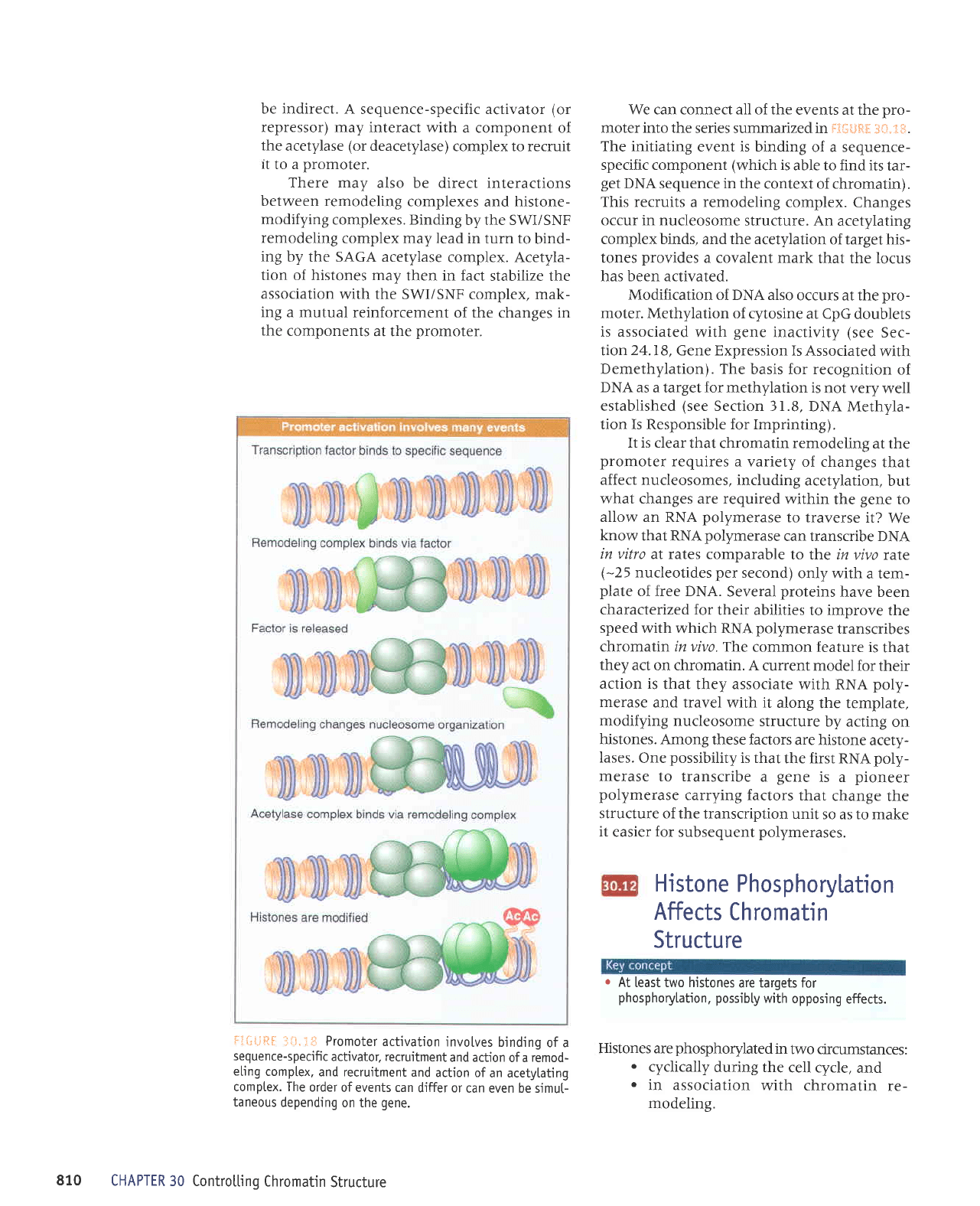
be indirect. A
sequence-specific activator
(or
repressor) may
interact
with
a component of
the
acetylase
(or
deacetylase)
complex to recruit
lt
to a
promoter.
There may
also be direct interactions
between remodeling
complexes
and
histone-
modifying
complexes. Binding
by the SWI/SNF
remodeling
complex may
lead in turn to
bind-
ing
by the SAGA acetylase
complex. Acetyla-
tion of histones may
then in fact
stabilize the
association
with the SWI/SNF
complex, mak-
ing
a
mutual
reinforcement
of the changes in
the
components
at the
promoter.
Ii*ijRl
-:tii.:+: Promoter
activation
invotves
binding
of a
sequence-specific
actjvator, recruitment
and actjon
of a
remoo-
eling
comptex,
and recruitment
and
action of
an acetytating
comptex. The
order
ofevents can
differ or
can even be sjmut-
taneous
depending
on the
gene.
We can connect all of the
events at the
pro-
moter into the
series summarized in ftf:#gtil
3{,i.ti.*.
The initiating
event is binding
of a sequence-
specific component
(which
is
able to find its
tar-
get
DNA sequence in the
context of chromatin).
This recruits
a
remodeling
complex.
Changes
occur in nucleosome
structure. An
acetylating
complex binds, and the acetylation
of target his-
tones
provides
a covalent mark
that the locus
has been activated.
Modification
of DNA also
occurs at the
pro-
moter. Methylation of cytosine
at CpG
doublets
is associated
with
gene
inactivity
(see
Sec-
Iion24.I8, Gene Expression Is
Associated
with
Demethylation). The
basis for recognition
of
DNA as
atargel for methylation is
not very
well
established
(see
Section 31.8,
DNA Methyla-
tion Is Responsible for Imprinting).
It is clear
that chromatin remodeling
at the
promoter
requires a
variety of changes
that
affect nucleosomes,
including
acetylation,
but
what changes are required
within
the
gene
to
allow an RNA
polymerase
to traverse
it?
We
know
that RNApolymerase
can transcribe DNA
in vitro
at rates comparable
to the in
vivo rare
(-25
nucleotides
per
second)
only with
a tem-
plate
of free DNA.
Several
proteins
have been
charactedzed for
their abilities
to
improve
the
speed with
which RNA
polymerase
transcribes
chromatin in vivo. The
common
feature is
that
they
act on chromatin. A
current model
for their
action is
that they associate
with RNA
poly-
merase
and travel
with
it
along
the template,
modifying nucleosome
structure
by acting
on
histones. Among
these factors
are histone
acety-
Iases.
One
possibility
is that
the first RNA
poly-
merase
to transcribe
a
gene
is a
pioneer
polymerase
carrying factors
that
change
the
structure of the
transcription unit
so as to make
it
easier
for
subsequent
polymerases.
Histone
Phosphorylation
Aftects
Chromatin
Structure
r
At
least two histones
are targets for
phosphorylation,
possibty
with
opposing
effects.
Histones
are
phosphorylated
in
two circumstances:
.
cyclically
during the
cell cycle,
and
.
in association
with chromatin
re-
modeling.
810
CHAPTER
30 Controtting
Chromatin
Structure
